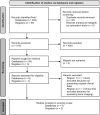Imaging in Craniofacial Disorders With Special Emphasis on Gradient Echo Black-Bone and Zero Time Echo MRI Sequences
- PMID: 36388002
- PMCID: PMC9648653
- DOI: 10.4103/jpn.JPN_46_22
Imaging in Craniofacial Disorders With Special Emphasis on Gradient Echo Black-Bone and Zero Time Echo MRI Sequences
Abstract
Context: The well-known effects of ionizing radiation on brain cells have been a major driving force toward the use of non-ionizing methods of imaging in both elective and emergency settings. Pediatric neurosurgery has certainly leveraged on this shift in clinical practice, however patients with craniofacial disorders could not fully benefit from the adoption of magnetic resonance imaging (MRI) because computed tomography (CT) scans still retain superior imaging power on bone tissue.
Aims: To explore the knowledge available on the use of MRI as surrogate for CT scan in the assessment of craniosynostosis.
Settings and design: A scoping review was designed to identify landmark studies and ongoing clinical trials exploring the accuracy of MRI-based bone imaging in the preoperative planning of pediatric patients with craniosynostosis.
Materials and methods: A total of 492 records were screened from Pubmed, Ovid Medline, Scopus, and Cochrane Library databases; while 55 records were retrieved from ClinicalTrials.gov register. Only clinical studies revolving around the use of Gradient Echo Black-Bone (BB) and Zero Time Echo (ZTE) MRI sequences for the preoperative planning of pediatric craniosynostosis were retained for inclusion.
Results and conclusions: This review identified only five clinical studies reporting a high accuracy of MRI-based 3D bone reconstruction in 47 pediatric candidates to surgical correction of craniosynostosis. Although promising, limited evidence (Level IV) exist that BB and ZTE MRI could help in the surgical planning for craniosynostosis management. The results of two ongoing randomized clinical trials, which are actively enrolling patients, will hopefully help answering this research question.
Keywords: 3D reconstruction; craniosynostosis; neuroradiology; pediatric neurosurgery; preoperative planning.
Copyright: © 2022 Journal of Pediatric Neurosciences.
Conflict of interest statement
There are no conflicts of interest.
Figures
References
-
- McLaughlin DJ, Mooney RB. Dose reduction to radiosensitive tissues in CT. Do commercially available shields meet the users’ needs? Clin Radiol. 2004;59:446–50. - PubMed
-
- Ganau M, Syrmos NC, D’Arco F, Ganau L, Chibbaro S, Prisco L, et al. Enhancing contrast agents and radiotracers performance through hyaluronic acid-coating in neuroradiology and nuclear medicine. Hell J Nucl Med. 2017;20:166–8. - PubMed
-
- Hersh DS, Bookland MJ, Hughes CD. Diagnosis and management of suture-related concerns of the infant skull. Pediatr Clin North Am. 2021;68:727–42. - PubMed
Publication types
LinkOut - more resources
Full Text Sources

